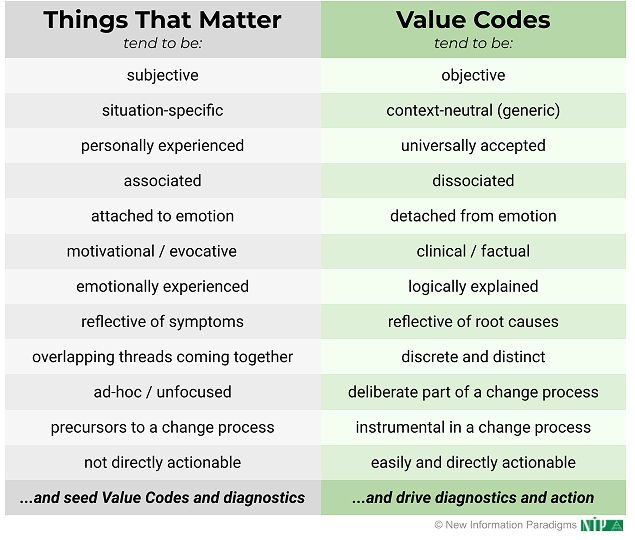Value Management: What It Involves
All Value Management applications are assembled from five elements:
These elements work together like this:
- Things That Matter (everything that is important in the situation, which is mostly subjective) are surfaced, captured and prioritised, after which…
- Value Coding makes them measurable and manageable, by developing Value Codes which are organised and presented within…
- ARC Diagnostics, which allow secure and limitlessly scalable evaluation of these Value Codes, but where how that evaluation works varies with…
- Value Modes, which are the different ways of thinking about and acting on what matters, and where the appropriate Value Mode finally depends on…
- Ecosystem & Lifecycle Positioning, which is what establishes the context of the situation in question, how it’s got to its current state and where it is heading.
And why do all these elements work together? Because they are all informed by the key underlying principles of being:
To elaborate on each element:
Things That Matter
- The Things That Matter are what constitute Value to the People involved – whether customers, suppliers, partners or other stakeholders – as they navigate Complex situations and challenges.
- The Things That Matter therefore capture what is typically ignored or impossible to address with conventional approaches.
Value Coding

- Value Coding is where the Things That Matter are re-expressed to make them measurable and manageable as Value Codes.
- Value Codes therefore reflect how People think, further grounding Value in ways that introduce objectivity to the subjective aspects of Complexity.
ARC Diagnostics
- ARC Diagnostics is our framework for structuring and securely presenting Value Codes for evaluation at limitless scale.
- Diagnostics therefore engage People at scale, catalysing creative thought and inputs on how to realise Value, encouraging discernment on how to navigate Complexity.
Value Modes
- Value Modes are the different ways of thinking about Value and which influence how ARC Diagnostics are used, and the configuration of functionality used.
- Value Modes therefore give shape to Complexity, focusing activity for the People involved in Value-appropriate ways.
Ecosystem & Lifecycle Positioning
- Ecosystem & Lifecycle Positioning guides the selection and sequencing of Value Modes, with Ecosystem positioning organisations and initiatives in relation to each other, and Lifecycle models establishing the position in time.
- An understanding of Ecosystems & Lifecycles therefore helps map the journey through Complexity, so that the People involved understand what perspectives to adopt whilst considering the Value realised and yet to be realised.

The case for a Value Management function:
Featured content:
- How and why “Things That Matter” is the bedrock of Value Management
- Things That Matter and Value Coding make Value Management SMARTER than SMART
- How Value Management is the only approach that achieves transformation
- Explaining the Value Management logo: simplicity the other side of Complexity
Our series on how Tesla embody Value Management:
